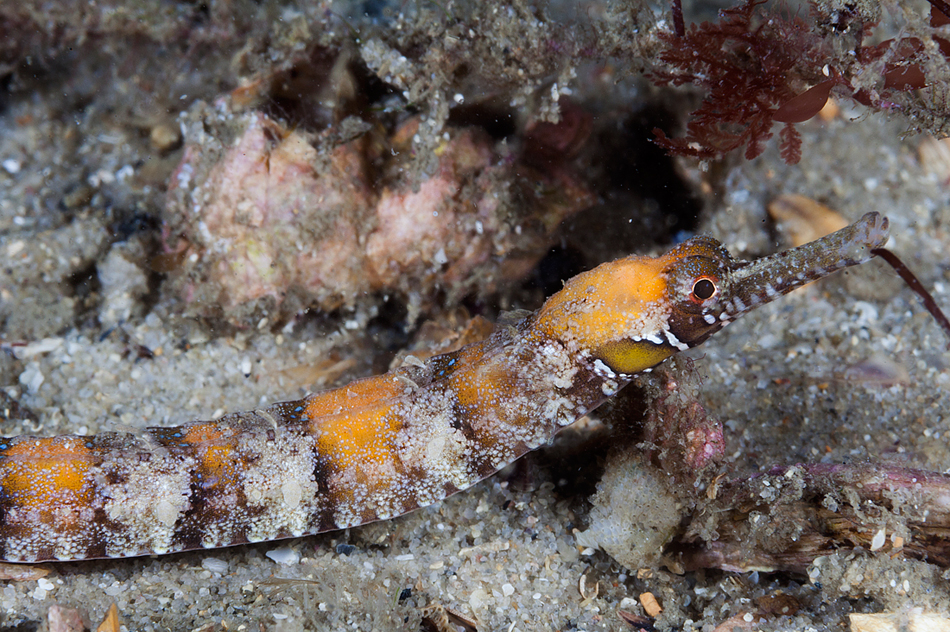Girdled Pipefish, Festucalex cinctus (Ramsay 1882)

A Girdled Pipefish, Festucalex cinctus, in Chowder Bay, Sydney Harbour, New South Wales. Source: Klaus Stiefel / Flickr. License: CC BY Attribution-Noncommercial
This secretive species is usually a light mottled brownish-orange with indistinct dark bars, an orange patch on the lower part of the gill cover and leafy appendages on the back. However, it is variable in colour, and ranges from pale greyish, to brown, and almost black.
Girdled Pipefish, Festucalex cinctus (Ramsay 1882)
More Info
|
Distribution |
Endemic to tropical and temperate waters of the Northern Territory, Queensland and New South Wales. Usually inhabits sheltered coastal bays and estuaries, on patches of rubble, sand or in areas of sparse seagrass, algal and sponge growth. |
|
Features |
Meristic features: Dorsal fin 21-28; Pectoral fin 12-14; Trunk rings 16-18; Tail rings 36-39. Head and body smooth, without spines or prominent ridges; some leafy appendages on back; head broad, snout slender. Superior and inferior ridges of trunk continuous with corresponding ridges of tail; principle ridges of last 1-2 tail rings modified, usually with projecting knobs or spinelike margins. Pectoral fin base protruding laterally without ridges in adults. |
|
Size |
Reaches a total length of about 16 cm. |
|
Colour |
Variable in colour, usually light brownish-orange, although it may also be very pale, or dark brown, grey, or even blackish, usually with irregularly mottling and 14-15 diffuse tan or pale bars across the back; opercle usually orange, and a persistent pale bar typically on postorbital. |
|
Feeding |
Unknown, but likely to feed on planktonic and benthic micro-crustaceans. |
|
Biology |
Males brood the eggs in a semi-enclosed pouch on the underside of the trunk. The protective plates of the pouch are distinct and the pouch folds barely meet on the midline of an egg-filled pouch. Males may begin brooding at 9.9 mm SL. |
|
Fisheries |
Has been taken as accidental bycatch in trawls. |
|
Conservation |
Marine listed under the Environment Protection and Biodiversity Conservation Act 1999. Protected under the New South Wales Fisheries Management Act. |
|
Remarks |
Specimens from northern Queensland and the Northern Territory appear to differ from those in New South Wales and may represent a different species . |
|
Similar Species |
Three species of Festucalex occur in Australian waters: Gibb's Pipefish, F. gibbsi, which occurs off north-eastern Queensland, and the Ladder Pipefish, F. scalaris, found off south-western Western Australia. The modified posterior tail rings, the pale postorbital bar and opercular margin, and the usually abundant dermal flaps are characteristic of F. cinctus and separate it from other species. F. scalaris has similar total ring counts but has brown spotting on the head, and the underside of the body is barred vs. no head spots and a plain underside in F. cinctus. |
|
Etymology |
Festucalex is from the Latin, festuca meaning 'stalk', 'straw coloured'. The specific name cinctus is from the Latin cincta meaning to 'gird'. |
|
Species Citation |
Syngnathus cinctus Ramsay 1882, Proc. Linn. Soc. N.S.W. (1)7(1): 111. Type locality: Port Jackson, NSW. |
|
Author |
Bray, D.J. & Thompson, V.J. 2017 |
Girdled Pipefish, Festucalex cinctus (Ramsay 1882)
References
Dawson, C.E. 1977. Synopsis of Syngnathine pipefishes usually referred to the genus Ichthyocampus Kaup, with description of new genera and species. Bull. Mar. Sci. 27(4): 595-650.
Dawson, C.E. 1985. Indo-Pacific Pipefishes (Red Sea to the Americas). Gulf Coast Research Laboratory, Ocean Springs, Mississippi. 230 pp.
Hoese, D.F., D.J. Bray, J.R. Paxton & G.R. Allen. 2006. Fishes. In Beesley, P.L. & A. Wells (eds). Zoological catalogue of Australia. Volume 35. ABRS & CSIRO Publishing: Australia. 2178 pp.
Kuiter, R.H. 1992. Tropical Reef-fishes of the Western Pacific Indonesia and Adjacent Waters. Gramedia, Jarkata. 314 pp.
Kuiter, R.H. 1993. Coastal Fishes of South-eastern Australia. Crawford House Press, Bathurst. 437 pp.
Kuiter, R.H. 1996. Guide to Sea Fishes of Australia. New Holland Press, Australia. 433 pp.
Kuiter, R.H. 2000. Seahorses, Pipefishes and their Relatives. TMC Publishing, Chorleywood, UK. 240 pp.
Kuiter, R.H. 2009. Seahorses and their relatives. Aquatic Photographics, 206 pp.
Larson, H.K. & R.S. Williams. 1997. Darwin Harbour Fishes: A Survey and Annotated Checklist. In: Hanley, J.R., G. Caswell, D. Megirian and H.K. Larson, eds. Proceedings of the Sixth International Marine Biological Workshop. The marine flora and fauna of Darwin Harbour, Northern Territory, Australia. Page(s) 339-380. Museums & Art Gal. of NT & AMSA: Darwin, Australia.
Pogonoski, J.J., D.A. Pollard & J.R. Paxton. 2002. Conservation Overview and Action Plan for Australian Threatened and Potentially Threatened Marine and Estuarine Fishes, Environment Australia, Canberra. 375 pp.
Paulus, T. 1999. Family Syngnathidae. pp 2264-2276, In Carpenter K.E. & Niem V.H. (eds) The Living Marine Resources of the Western Central Pacific. FAO Species Identification Guide For Fisheries Purposes. FAO Vol. 4. pp 2069-2790.
Ramsay, E.P. 1882. Notes on Apogon güntheri of Castelnau, and descriptions of two new fishes from N.S.W. Proc. Linn. Soc. N.S.W. (1)7(1): 110-112.






